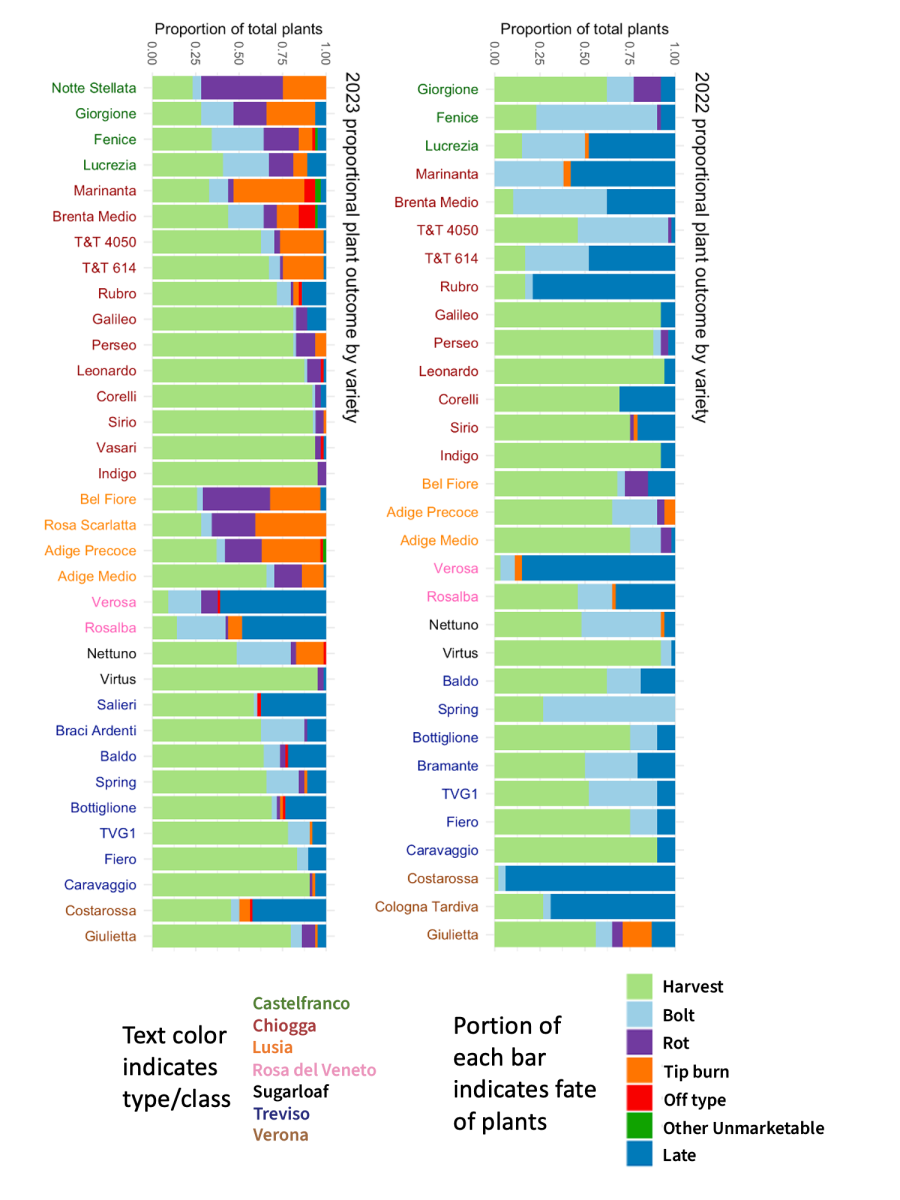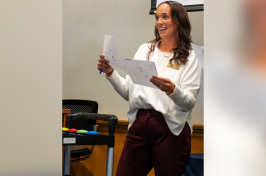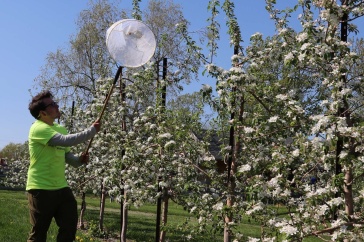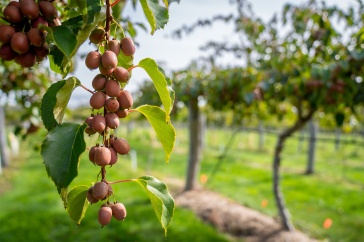Producing a diverse set of high-quality crops is a keystone component to the success and sustainability of many small and medium-sized New Hampshire farms. Another component is informed decision-making for capturing new marketing opportunities, such as the gaining popularity of radicchio—a colorful and bitter leafy vegetable popular in Italian cuisine—among restaurants and retailers in New England. With a potential for spring and late-fall production, average sales prices of $3–$6 per head and high levels of vitamin K sought out by consumers to support heart and brain health, Granite State farmers may be deciding whether to add radicchio to their crop mix. Scientists with the New Hampshire Agricultural Experiment Station (NHAES) are aiding this decision through their research examining which radicchio varieties perform best in northern New England's varied climate and how planting date impacts performance of this increasingly popular and valuable crop.
“Radicchio is becoming very trendy among chefs and local foodies so there’s been an explosion of interest in the crop,” said Station scientist Becky Sideman. “However, it’s been little studied, especially in the Northeast, and it’s a crop that’s highly variable and easily impacted by weather and climate. It’s performance here may be very different from where it is more commonly grown commercially, in the Pacific Northwest.”
“Because of all these factors,” she added, “it’s challenging for a farmer in New England just to begin growing it without information on best-performing varieties and ideal growing conditions – making it an ideal crop to study.”
“Within this part of the country, farmers often use specialty crops to distinguish themselves from other farms and the offerings in grocery stores. And as they become known for producing high quality products as signature offerings, this also benefits consumers, who gain access to unique local specialties.” ~ Becky Sideman, professor of agriculture, nutrition and food systems
The study was led by Sideman, professor of agriculture, nutrition and food systems at UNH’s College of Life Sciences and Agriculture (COLSA), with support from COLSA research scientist Lilly Hartman and undergraduate researcher Ella Lukacz ’24. In addition to conducting the study at UNH’s Woodman Horticultural Research Farm, the team’s partners at the University of Maine conducted the same study at UMaine’s Highmoor Farm. Together, they grew and observed over 30 cultivars of radicchio and examined how planting date impacted the weight and marketability of the radicchio heads.
The study identified the Chioggia type and varieties as having high marketability and resilience to disease—making them ideal choices for New England farmers. The data also indicated that planting radicchio in the third week of June maximized the harvest window, which may allow growers to simplify harvest operations.
The Chioggia type is the one most familiar to most U.S. consumers, with heads that are solid, round and frequently red (depending on variety). In this study, several Chioggia type varieties— including Indigo, Leonardo, and Perseo—experienced relatively little bolting and tip burn and consistently produced over 80 percent of marketable heads. Radicchio varieties within the Treviso type, which forms heads shaped like romaine hearts, frequently showed susceptibility to bolting, but the variety Caravaggio stood out for its bolt resistance in both 2022 and 2023. Virtus was a high performing variety within the Sugarloaf type, producing large, uniform heads. Varieties of Rosa del Veneto and Castelfranco types were also tested and showed greater variation.
“So far, we’ve seen huge differences in marketability among varieties, due to varying degrees of susceptibility to issues like bolting, tip burn and rotting,” described Hartman. “And we’ve observed that some varieties just don’t have enough time at their preferred temperatures to mature during our rather short growing season.”
Because the study took place over an unusually dry 2022 growing season and a wetter-than-average 2023 season, the research team was able to observe how varieties responded to very different challenges commonly experienced by radicchio growers, including rot, bolting (or premature flowering) and tip burn, a disorder that leads to browning leaves and dead leaf tips.
The team observed that some varieties were affected more than others by the seasonal variation. Added Sideman, “We observed more bolting in 2022, and more rot in 2023 – as you’d expect given the weather conditions. And it was exciting to see that some varieties produced quite good yields in both years.”
The research team plans to conduct further experiments in 2024 and beyond to address additional questions, such as how the rate and timing of nitrogen application affects marketable yields and how cold temperature exposure and maturity at harvest impact color development and post-harvest storage. This ongoing research is part of a broader project led by Sideman and supported by the NHAES examining several varieties of specialty crops, including seedless table grapes and hydrangeas for regional cut-flower markets, as well as production systems and practices for high-tunnel grown tomatoes and overwintering of strawberries and cold-climate figs.
“Within this part of the country, farmers often use specialty crops to distinguish themselves from other farms and the offerings in grocery stores,” said Sideman. “And as they become known for producing high quality products as signature offerings, this also benefits consumers, who gain access to unique local specialties.”
You can read the full research report, "Radicchio Cultivar Performance in New Hampshire," on the University of New Hampshire Scholars' Repository.
This material is based on work supported by the NH Agricultural Experiment Station through joint funding from the USDA National Institute of Food and Agriculture (under Hatch award numbers 7003420) and the state of New Hampshire. Additional support came from the NH Vegetable & Berry Growers’ Association and the UNH Cooperative Extension.

-
Written By:
Nicholas Gosling '06 | COLSA/NH Agricultural Experiment Station | nicholas.gosling@unh.edu


























































